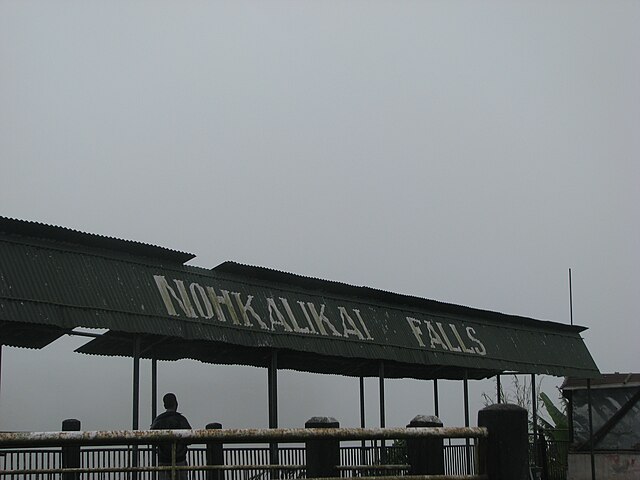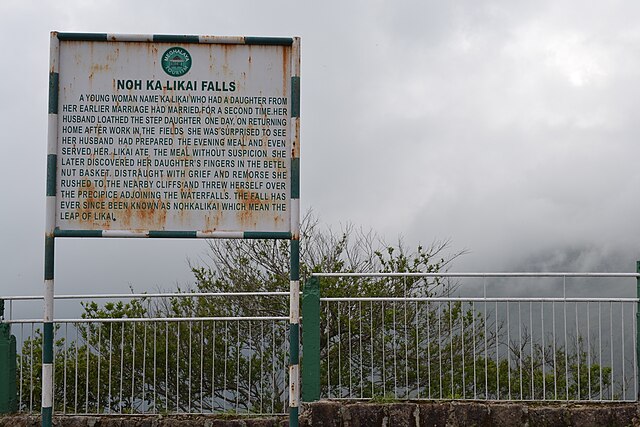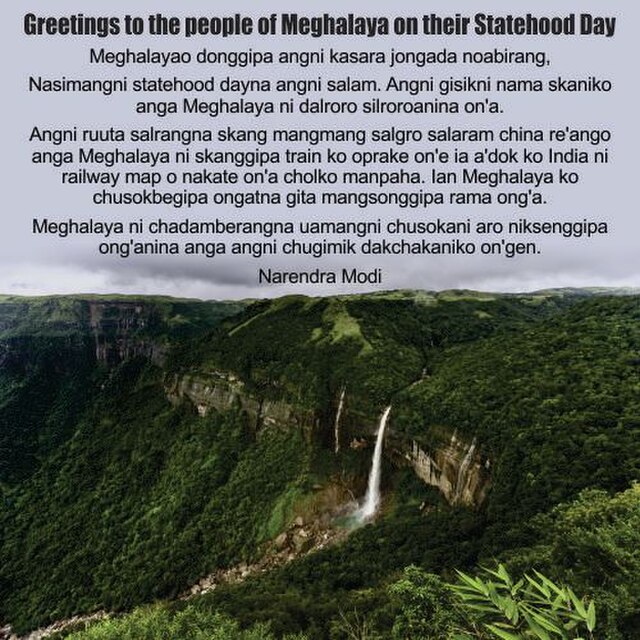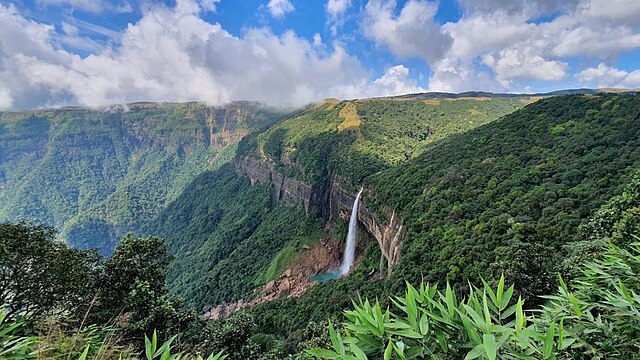Have you ever wondered what it feels like to witness nature’s raw power cascading from unimaginable heights? Welcome to Nohkalikai Falls, where water plunges 1,115 feet into a emerald pool below, creating one of India’s most breathtaking natural spectacles. This isn’t just any waterfall – it’s a testament to nature’s artistry and a keeper of ancient legends.
What Makes Nohkalikai Falls Special?
Standing at the edge of Cherrapunji’s cliffs, Nohkalikai Falls commands respect and awe. But what exactly sets this waterfall apart from the thousands of others scattered across India’s landscape?
The Stunning Height and Geography
Picture this: you’re standing on a cliff, and before you, water free-falls for over 1,100 feet – that’s equivalent to a 100-story building! Nohkalikai holds the prestigious title of being India’s tallest plunge waterfall, where water drops vertically without touching any rock surface until it reaches the bottom.
The waterfall originates from a stream that flows through the East Khasi Hills, gathering momentum before making its dramatic leap. During peak monsoon season, the volume of water creates a thunderous roar that can be heard from miles away. The mist generated by the impact creates its own microclimate, supporting unique flora and fauna around the base.
Unique Plunge Waterfall Formation
Unlike cascading waterfalls that flow over multiple tiers, Nohkalikai is a true plunge waterfall. The geological formation here is fascinating – the Khasi Hills’ sandstone and limestone layers have been carved by centuries of erosion, creating these spectacular vertical drops. The rock face is so steep that the water literally jumps off the cliff, creating that iconic free-fall effect that photographers and nature lovers chase.
The Tragic Legend Behind the Name
Every great natural wonder has a story, but Nohkalikai’s tale will tug at your heartstrings. The name itself carries centuries of local folklore that adds a haunting beauty to this already mesmerizing waterfall.
Ka Likai’s Heartbreaking Story
According to Khasi legend, there once lived a woman named Ka Likai in a nearby village. She was a devoted mother who worked tirelessly to provide for her infant daughter after her husband’s death. To make ends meet, she would leave her baby with neighbors while she worked in the fields.
Ka Likai remarried, hoping to provide better care for her child. However, her new husband grew jealous of the attention she gave to her daughter. In a fit of rage and jealousy, he committed an unthinkable act – he killed the infant and cooked the flesh, serving it to Ka Likai when she returned from work.
How the Waterfall Got Its Name
When Ka Likai discovered the horrifying truth through finding her baby’s fingers in her food basket, she was consumed by grief and madness. Unable to bear the pain, she ran to the cliff and jumped to her death. The locals named the waterfall “Nohkalikai,” which translates to “Jump of Ka Likai” in the Khasi language.
This tragic tale adds a layer of mystique to the waterfall, reminding visitors that behind natural beauty often lies human stories of love, loss, and tragedy. Many locals believe Ka Likai’s spirit still watches over the falls, protecting mothers and children who visit.
Where is Nohkalikai Falls Located?

Finding this natural wonder requires a journey to one of Earth’s wettest places, but the destination is worth every mile traveled.
Cherrapunji: The Wettest Place on Earth
Nohkalikai Falls is located near Cherrapunji (also known as Sohra) in Meghalaya’s East Khasi Hills district. Cherrapunji holds multiple world records for rainfall, receiving over 450 inches annually. This incredible precipitation is what feeds Nohkalikai and keeps it flowing year-round.
The town sits at an elevation of about 4,500 feet above sea level, providing the perfect topography for spectacular waterfalls. The combination of high altitude, monsoon winds, and steep cliffs creates the ideal conditions for Nohkalikai’s formation.
Meghalaya’s Natural Wonders
Meghalaya, meaning “abode of clouds,” lives up to its name. The state is a treasure trove of natural wonders, with Nohkalikai Falls being the crown jewel. The region’s unique geography, influenced by the Khasi Hills and monsoon patterns, has created a landscape that seems almost otherworldly.
The falls are approximately 5 kilometers from Cherrapunji town center, making them easily accessible for day trips. The area is part of a larger ecosystem that includes several other waterfalls, caves, and the famous living root bridges that have made Meghalaya a must-visit destination for nature enthusiasts.
Best Time to Visit Nohkalikai Falls
Timing your visit can make the difference between a good experience and an absolutely unforgettable one. Like a symphony, Nohkalikai Falls performs differently throughout the year.
Monsoon Season Magic
June through September brings the monsoon season, when Nohkalikai Falls is at its most powerful and dramatic. During this time, the waterfall is a raging torrent, with massive volumes of water creating a spectacular display. The sound is deafening, the mist is thick, and the entire experience is incredibly intense.
However, visiting during monsoons comes with challenges. Heavy rains can make roads slippery and dangerous, visibility might be poor due to fog and mist, and landslides are a real concern. If you’re an adventure seeker who doesn’t mind getting soaked and wants to see the falls at their most powerful, monsoon season is your time.
Post-Monsoon Clarity
October through December offers the perfect balance – the waterfall still has good water flow from recent rains, but the weather is clearer and more comfortable for sightseeing. This period provides the best photography opportunities, as the sky is usually clear, and you can capture the full height and beauty of the falls without obstruction.
Winter Months Advantages
January through March brings cooler, drier weather. While the water flow is reduced compared to monsoon season, the visibility is excellent, and the weather is pleasant for hiking and exploring. This is ideal if you’re traveling with family or prefer comfortable weather conditions.
The reduced water flow actually allows you to appreciate the geological formations better, and you might even spot some of the unique plants and birds that call this area home.
How to Reach Nohkalikai Falls
Getting to Nohkalikai Falls is an adventure in itself, taking you through some of Northeast India’s most beautiful landscapes.
From Shillong to Cherrapunji
Most visitors start their journey from Shillong, Meghalaya’s capital, which is well-connected by air and road to major Indian cities. From Shillong, Cherrapunji is about 56 kilometers away – a drive that typically takes 1.5 to 2 hours depending on road conditions and weather.
The route from Shillong to Cherrapunji is scenic but can be challenging, especially during monsoons. The road winds through hills, forests, and small villages, offering glimpses of local Khasi culture and stunning valley views.
Transportation Options
You have several options for reaching the falls:
Private taxi or car rental: This gives you the flexibility to stop for photos and explore at your own pace. Local drivers are familiar with the best viewpoints and can share stories about the area.
Shared taxis: More economical but less flexible, shared taxis run regularly between Shillong and Cherrapunji.
Local buses: The most budget-friendly option, though they can be crowded and uncomfortable for longer journeys.
Once you reach Cherrapunji, local transportation or a short walk will take you to the Nohkalikai Falls viewpoint.
What to Expect at the Viewpoint

The moment you arrive at the Nohkalikai Falls viewpoint, you’ll understand why this place has captivated visitors for generations.
The Spectacular View
The designated viewpoint offers a panoramic view of the waterfall and the valley below. From here, you can truly appreciate the scale and majesty of Nohkalikai Falls. The viewing platform is well-maintained and safe, with railings to prevent accidents while allowing unobstructed views.
On clear days, you can see for miles across the Sylhet plains of Bangladesh. The contrast between the lush green hills of Meghalaya and the flat plains below creates a striking visual that photographers absolutely love.
Photography Opportunities
Nohkalikai Falls is a photographer’s paradise, offering opportunities for everything from wide landscape shots to detailed close-ups of the mist and rainbow effects.
Best Camera Settings
For the best results, use a polarizing filter to reduce glare and enhance the contrast between the white water and green surroundings. A neutral density filter can help you achieve those smooth, silky water effects that make waterfall photography so captivating.
Long exposure shots during the day can create dreamy, ethereal images where the water appears as a smooth white ribbon against the cliff face. Early morning and late afternoon provide the best lighting conditions, with the possibility of catching rainbows in the mist.
Nearby Attractions Worth Visiting
Why limit yourself to just one wonder when Cherrapunji offers a treasure trove of natural attractions?
Seven Sisters Falls
Just a short distance from Nohkalikai, the Seven Sisters Falls (also known as Nohsngithiang Falls) offers a completely different but equally spectacular experience. During monsoon season, seven distinct streams cascade down the cliff face, creating a stunning display that rivals Nohkalikai itself.
Mawsmai Cave
For those seeking underground adventures, Mawsmai Cave provides an exciting spelunking experience. These limestone caves are well-lit and safe for tourists, featuring impressive stalactite and stalagmite formations that have been created over thousands of years.
Living Root Bridges
No trip to Meghalaya is complete without experiencing the famous living root bridges. These incredible bio-engineering marvels are created by training the roots of rubber trees to grow across streams and valleys, forming natural bridges that grow stronger over time.
The nearest living root bridges to Cherrapunji require some hiking, but the experience of walking across a bridge made entirely of living tree roots is absolutely unforgettable.
Tips for Visiting Nohkalikai Falls

A little preparation can make your visit to Nohkalikai Falls safer and more enjoyable.
Safety Precautions
Always stay within designated viewing areas and never attempt to climb down to the base of the falls. The rocks can be extremely slippery, and the area around the pool at the base is not accessible to tourists for safety reasons.
Weather can change rapidly in this region, so always check local conditions before heading out. During monsoon season, be extra cautious about landslides and flash floods.
What to Bring
Pack layers of clothing, as temperatures can vary significantly throughout the day. A good rain jacket is essential, even during dry season, as the mist from the falls can soak you quickly.
Sturdy, non-slip shoes are crucial for navigating potentially wet and slippery surfaces. Don’t forget your camera, extra batteries, and perhaps a waterproof case to protect your equipment from the mist.
Bring snacks and water, as facilities near the falls are limited. Local vendors may be available, but it’s better to be prepared.
Conclusion
Nohkalikai Falls stands as more than just India’s tallest plunge waterfall – it’s a testament to nature’s power, a keeper of ancient legends, and a photographer’s dream rolled into one spectacular destination. Whether you’re drawn by the tragic beauty of Ka Likai’s story, the thrill of witnessing 1,115 feet of free-falling water, or simply the desire to experience one of India’s most incredible natural wonders, Nohkalikai Falls delivers an unforgettable experience.
The journey to reach this magnificent waterfall takes you through some of Northeast India’s most beautiful landscapes, and the region offers enough attractions to fill several days of exploration. From the thunderous roar during monsoon season to the crystal-clear views in winter, Nohkalikai Falls offers something special regardless of when you visit.
Remember to approach this natural wonder with respect – for the environment, for local customs, and for the tragic legend that gives this waterfall its name. In doing so, you’ll not only have an amazing experience but also help preserve this incredible destination for future generations to discover and cherish.
Frequently Asked Questions
1. Is it safe to swim in the pool at the base of Nohkalikai Falls? No, swimming is not permitted and is extremely dangerous. The pool at the base is not accessible to tourists, and the powerful current and depth make it unsafe. Always stay within designated viewing areas for your safety.
2. How long does it take to properly visit Nohkalikai Falls? Plan to spend at least 2-3 hours at the site to fully appreciate the views, take photographs, and explore the immediate area. If you’re combining it with other nearby attractions like Seven Sisters Falls or Mawsmai Cave, allocate a full day for the trip.
3. Are there accommodation options near Nohkalikai Falls? While there are no hotels directly at the falls, Cherrapunji town (about 5 km away) offers various accommodation options ranging from budget guesthouses to comfortable resorts. Shillong, with more extensive lodging choices, is about 2 hours away.
4. Can Nohkalikai Falls be visited year-round? Yes, the falls can be visited throughout the year, though the experience varies significantly by season. Monsoon season (June-September) offers maximum water flow but challenging weather conditions, while winter months (December-February) provide clearer views but reduced water volume.
5. What’s the entry fee for Nohkalikai Falls viewpoint? There is typically a nominal entry fee for accessing the viewpoint area, which helps maintain the facilities and viewing platforms. The fee is usually very affordable (around ₹10-20 per person), but it’s best to check current rates as they may change seasonally or with facility improvements.

